Seventy-nine years ago, in the final days of World War II in Europe, Czech citizens and members of its resistance launched a final assault against the Nazis.
The Prague Uprising lasted for five days and came to represent a symbol of Czech resistance in World War II.
Czech police officers burst into the radio station at Vinohradská Street and battled with the SS soldiers who were already occupying the building.
At 12:33 Prague radio called on all Czechs to take up arms in the organized resistance: it was the beginning of five days of fierce fighting that would see thousands lose their lives.
With the sound of combat as a backdrop, the announcer asked for public support with the following message: “Calling all Czechs. Come to our help at once. Come and defend Czech Radio. The SS are murdering Czech people here. Come and help us. You can still get through the Balbínova Street entrance…”
Resistance fighters in other parts of the city took over the Gestapo and SiPo headquarters. Civilians finally removed the hated German signs and began to attack and disarm the Germans. Barricades were built in the streets.
Antonin Sum, a teenager at the time, was involved in the resistance. “The uprising started in Prague,” he said. “You could see in the streets, as I saw myself, people with guns, which was absolutely impossible before. They were guns that had been hidden away somewhere underground in caves.… It was just the start, but nobody knew what was practically going on.”
In scenes reminiscent of European uprisings in the 19th century, cobblestones were torn from the streets to form the foundations of barricades. Carts, vehicles, and trolleys were overturned to block key intersections, and snipers took to the rooftops overlooking choke points.
By May 6, over 1,600 barricades had been constructed by thousands of citizens overnight. German reinforcements made their way to Prague and the fighting continued to escalate.
The Luftwaffe began to bomb areas of the city, hitting the radio broadcasting building, barricades, and civilian apartments. A battalion of the Russian Liberation Army (ROA), a German army unit made up of Soviet POWs, defected and came to the aid of Czech defenders, successfully disarming thousands of German troops.
On May 7, while German leaders were signing their unconditional surrender to the Allied forces in France, German forces in Prague launched a massive attack on the city.
Upon hearing the news of Germany’s surrender, the ROA, who had been successful in slowing the German advance on the city, left Prague to surrender to the US Army. With a majority of the ROA gone, the ill-equipped resistance fighters suffered against the reinforced German units and lost much of the territory they gained over the first days of the uprising.
Fighting continued in Prague even after the official Nazi surrender on May 7th. On May 8th, the Germans launched an air raid followed by a ground attack, with SS forces retaking key positions like the Masaryk rail station, where they brutally executed approximately 50 captured resistance fighters.
Facing critical situations on both sides and with Allied assistance still absent, Czech and German leaders negotiated a ceasefire. The agreement allowed German forces to pass through Prague westward on the condition of disarmament.
On the morning of May 9th, German forces left Prague. Later that day, the Soviet Red Army arrived and subdued any remaining German units in the city. Czech citizens jubilantly flooded the streets to welcome the Red Army and celebrate their liberation.
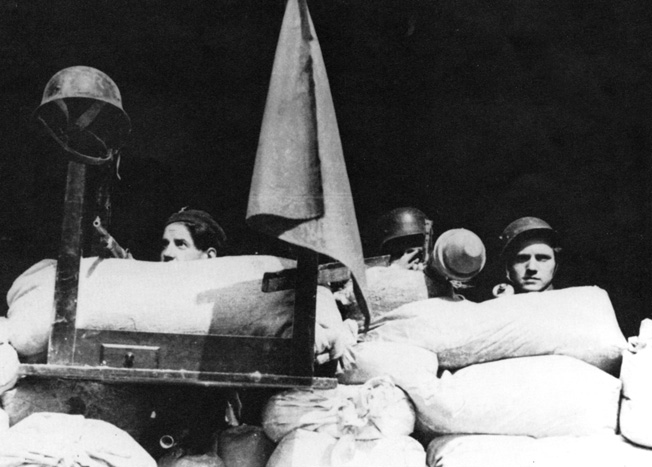

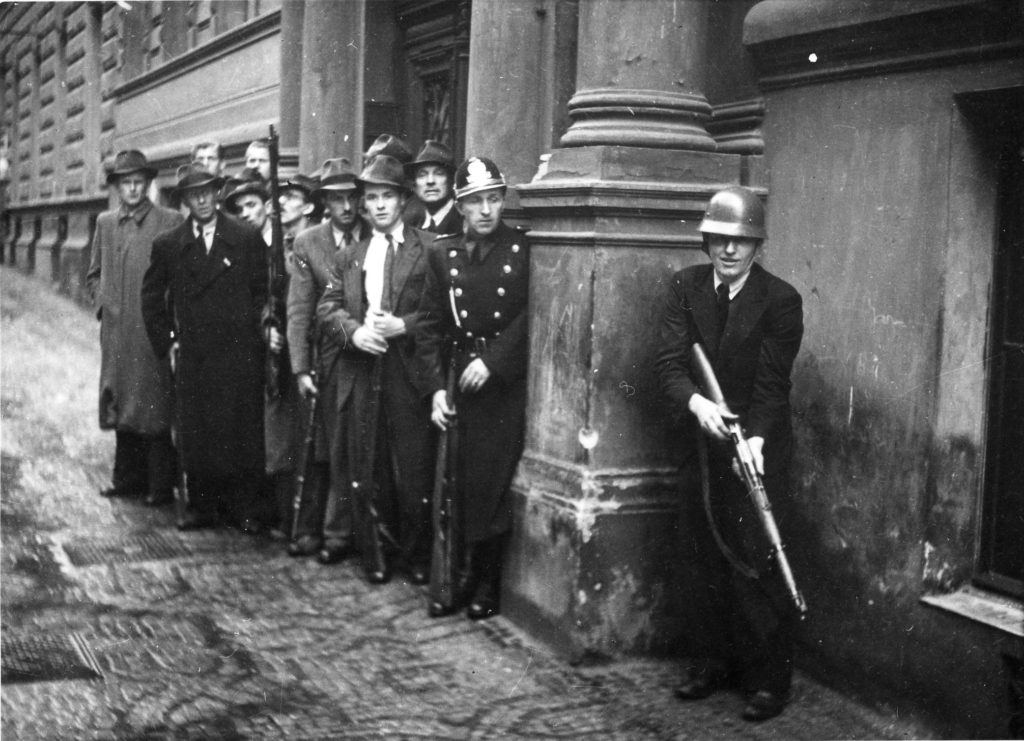
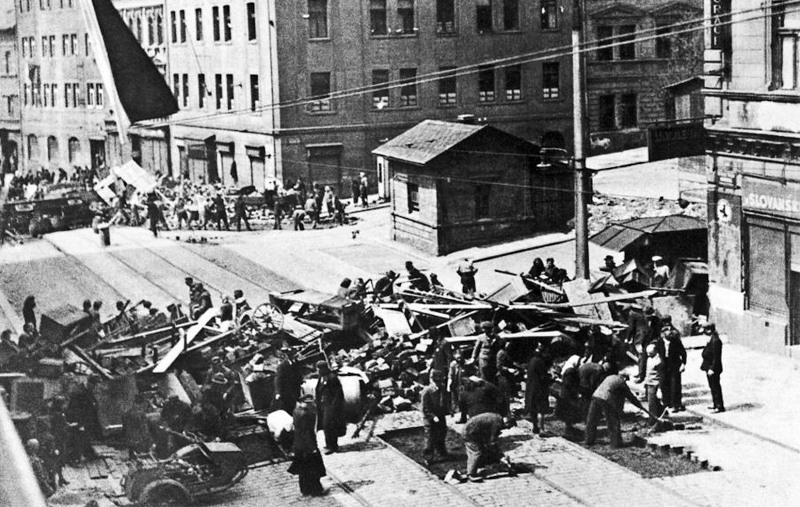
On May 7th, freshly arrived Wehrmacht and Waffen SS units started attacking from the North and east of Prague.
Some of the most intense fighting took place in Strašnice, just east of Žižkov.
The district was important because it housed the reserve radio station, to which the Czechoslovak broadcasters were forced to move after a 500kg bomb dropped by a German jet-fighter had destroyed their equipment in the main building of Czechoslovak Radio.
Luckily a resistance unit had managed to capture some Hetzer tank destroyers and keep the Germans away from the radio station.
German bombers flew in on May 7 and bombed the city, causing the destruction of most of the Old Town Hall; the centuries-old building was almost completely gutted and had to be torn down.
The top of the tower was also destroyed, and damage was caused to the famous Astronomical Clock. The Germans’ superior firepower gradually overwhelmed the Czech fighters, whose ammunition was insufficient.
While all this was going on, German leaders accepted the inevitability of unconditional surrender.
Armored and artillery units pushed their way through the barricades, using civilians as human shields along the way. Upon hearing the news of Germany’s surrender, the Russian Liberation Army (ROA), who had been successful in slowing the German advance on the city, left Prague to surrender to the US Army.
On May 7, 1945, the German High Command, in the person of General Alfred Jodl, signs the unconditional surrender of all German forces, East and West, at Reims, in northeastern France.
At first, General Jodl hoped to limit the terms of the German surrender to only those forces still fighting the Western Allies. But General Dwight Eisenhower demanded a complete surrender of all German forces, those fighting in the East as well as in the West.
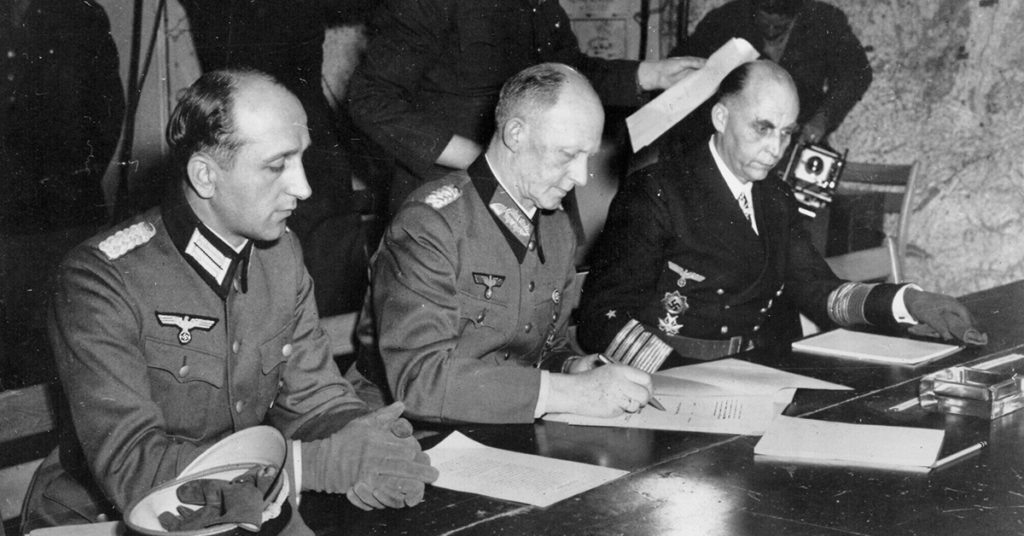
Franklin D. Roosevelt LibraryNazi Col. Gen. Alfred Jodl, center, signs the instrument of surrender ending Nazi Germany’s involvement in World War II in Rheims on May 7, 1945.
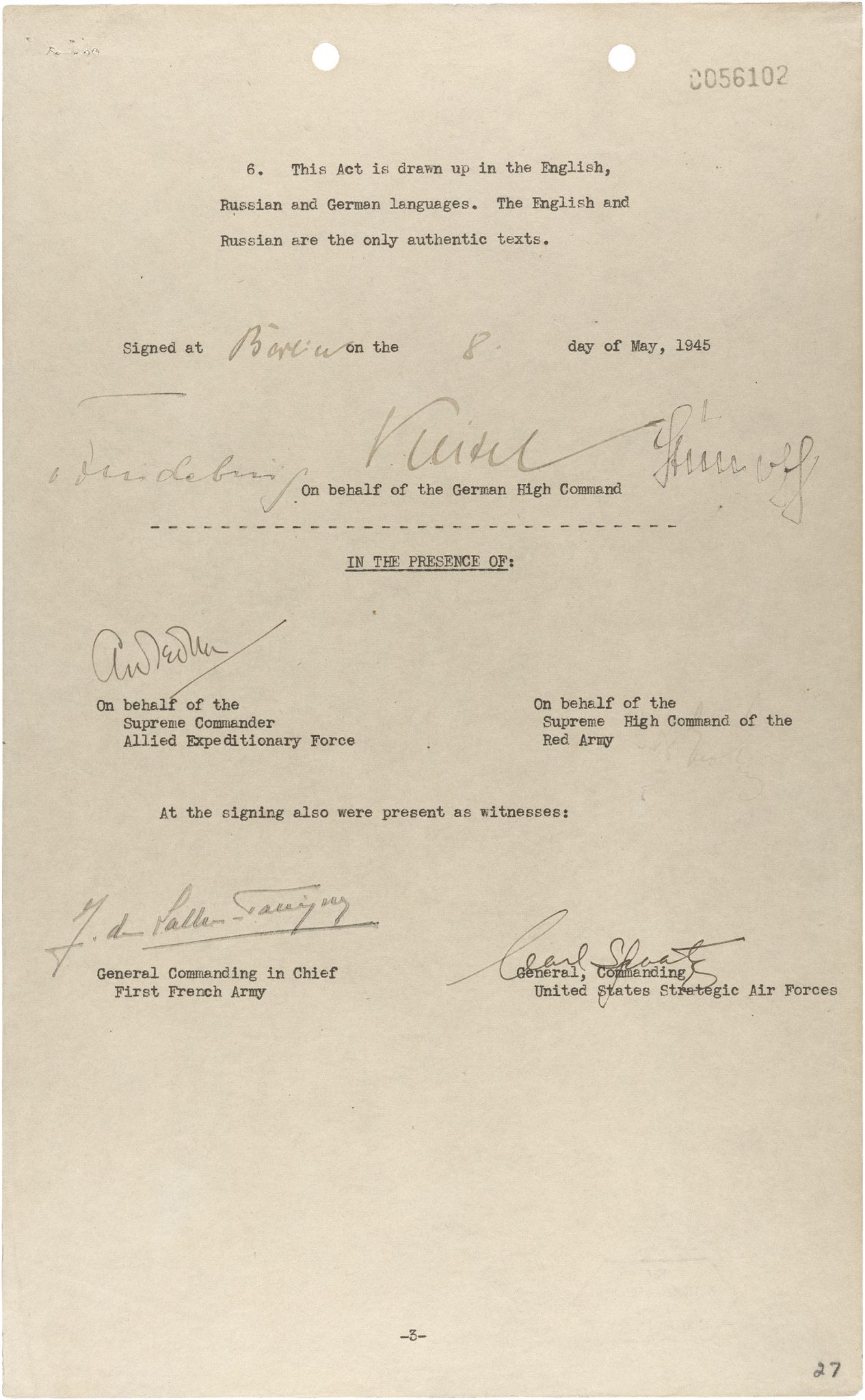
In Prague, May 6 was a day of crisis. The Germans retook the main radio station, but Czech partisans continued broadcasting from another base.
About half the city was occupied by the resistance, and his scattered units needed time to concentrate.
Barricades and snipers made treks to assembly points hazardous affairs, but the Germans were able to gather units close to the radio station.
Reinforced with the SS units, the Germans struck at the radio station. As resistance fighters tried to stem the tide of infantry, assault guns, and tanks, a new voice came over the airwaves begging for help from the Allies.
“Prague is in great danger! The Germans are attacking with tanks and planes. We are calling urgently our allies to help. Send tanks and aircraft immediately. Help us defend Prague. At present, we are broadcasting from the radio station. Outside, there is a battle raging.”
The voice belonged to William Grieg, a Scottish POW who had escaped from the Germans. Grieg found himself in the middle of the uprising and was asked by the Czechs to make the appeal. With fighting erupting all around him, Grieg calmly sat in front of the microphone and sent out the urgent request.
Meanwhile, the Head of the Russian Liberation Army Andrey Vlasov received a request from the commander of the first ROA division, General Sergei Bunyachenko, for permission to turn his weapons against the Nazi SS forces and aid Czech resistance fighters in the Prague uprising.
Vlasov at first disapproved, then reluctantly allowed Bunyachenko to proceed. Some historians maintain it was the bitterness of the ROA against the Germans which caused them to switch sides once again, while other historians believe the sole purpose of this action was to win favor from the western Allies and possibly even the Soviet side, in the light of the nearly completed military annihilation of the German Reich.
The Czechs fought bravely, but the Germans were too strong. They recaptured the radio station, but Czech engineers had already removed enough equipment to set up another broadcasting center in a safer part of the city.
Grieg was called back into action later during the uprising to ask for an Allied airstrike against a German armored column that was advancing on the city. Unlike his first appeal, that request was answered and the German column was decimated.
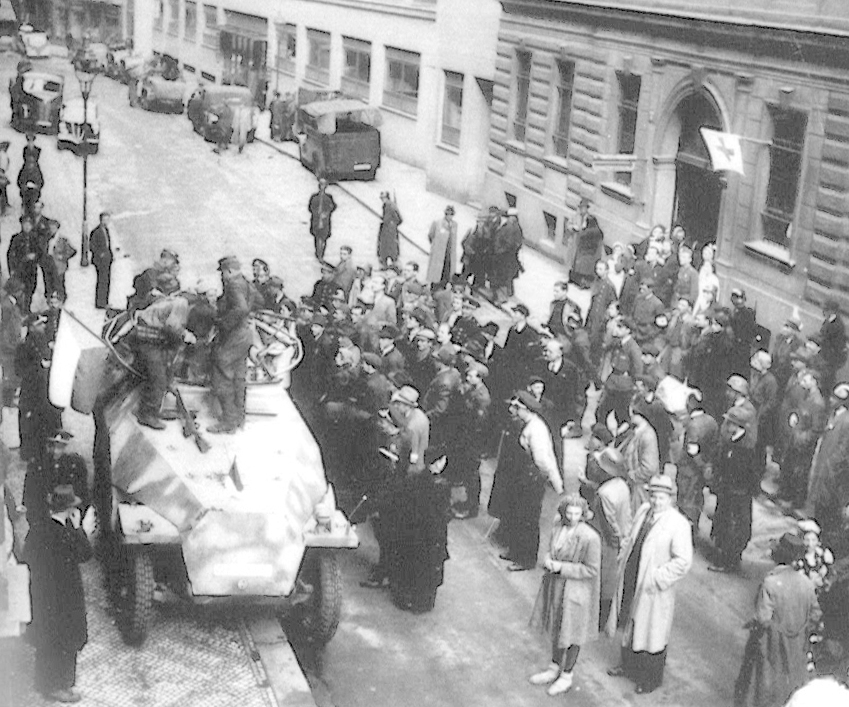
Photo: Pavel Žáček
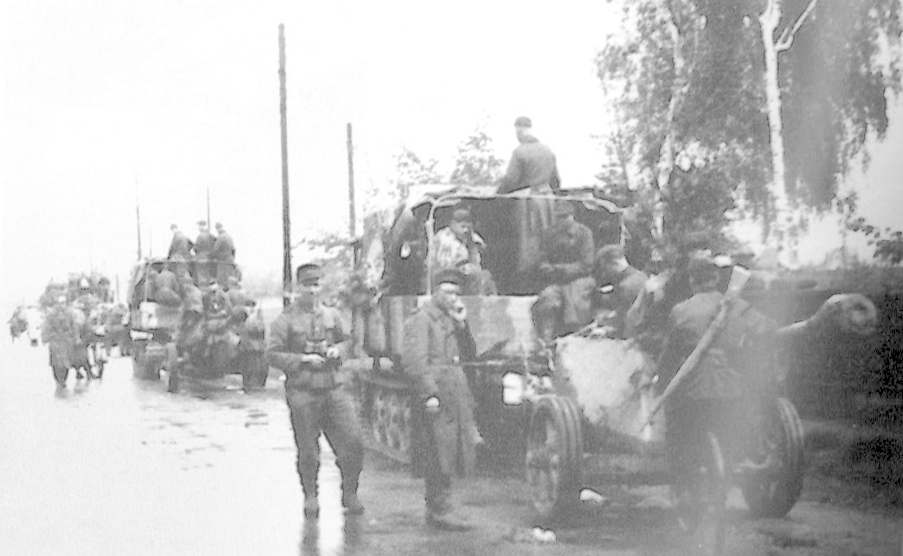
Photo: Pavel Žáček
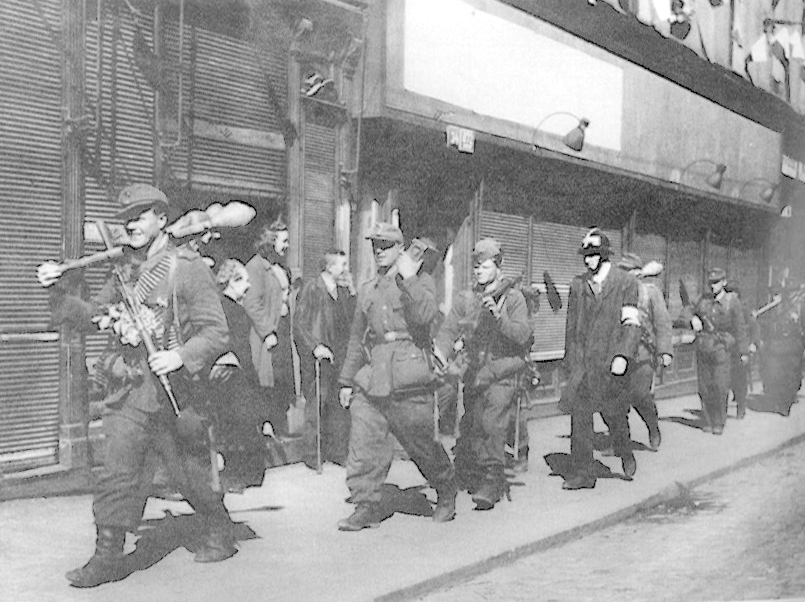
Photo: Pavel Žáček
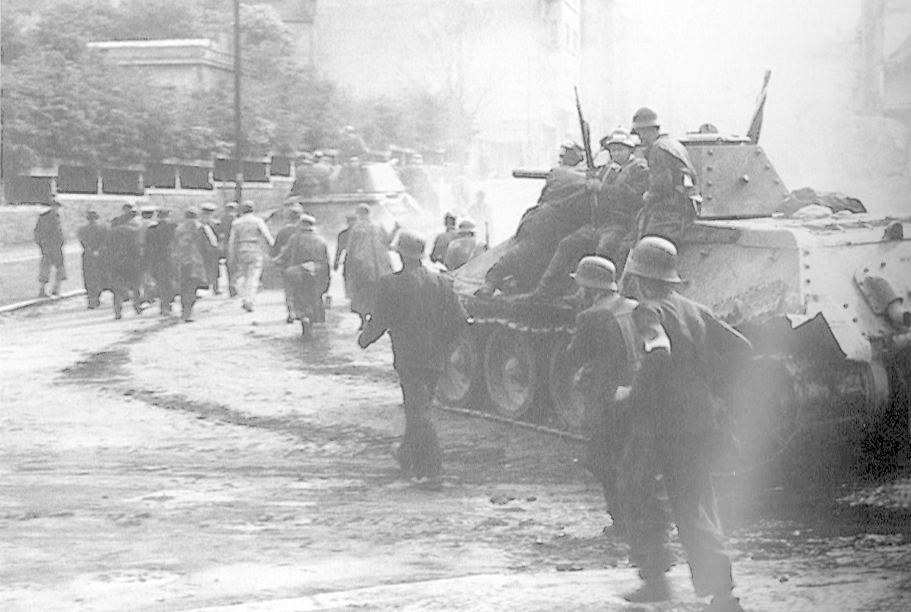
Photo: Pavel Žáček

